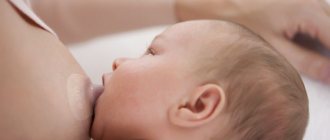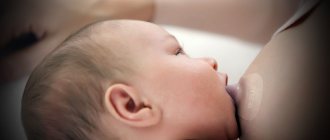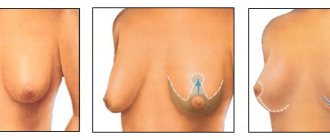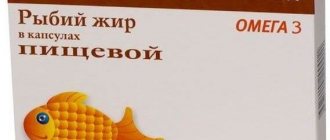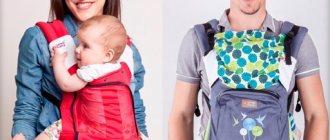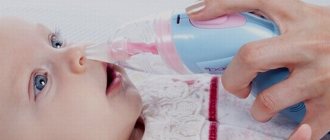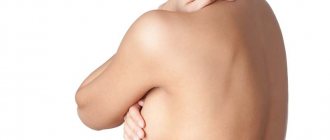When and why are nipple shields needed?
First of all, it should be noted that the need to purchase additional accessories, often recommended in the maternity hospital or advertising brochures, is usually exaggerated. The special shape of the mother's nipples and cracks that often appear at the initial stage of feeding are not an obstacle to successful feeding - all these difficulties are temporary and easily overcome. However, there are still situations when the use of overlays is justified.
Cases when using breast pads is necessary
- Unbearable pain when feeding, especially in first-time mothers. Non-healing nipple injuries, combined with a mother’s low pain threshold, in some cases can lead to the fact that a woman, exhausted by constant discomfort, simply refuses to breastfeed and is ready to switch the baby to formula. Of course, when choosing between artificial feeding and feeding with pads, you should give preference to the second option.
- Abnormal structure of the infant's oral cavity (short frenulum of the tongue). The child’s tongue is actively involved in feeding, and in the presence of such a pathology, the baby is not able to properly grasp the mother’s nipple and properly stimulate it. In this case, an alternative to cutting the frenulum can be overlays.
- Feeding “special groups” of newborns: premature, weakened, children with central nervous system damage. Such babies are often physically not ready to fully suckle, they lose weight, the mother’s lactation is also not properly stimulated, and under pressure from doctors the child is transferred to formula. Breastfeeding pads make it easier for the baby to suck and thereby preserve the mother's milk he needs in sufficient quantities.
- Transition from artificial to breastfeeding. If a newborn is forced to bottle feed for some time, there is a danger of getting used to the nipple and subsequent refusal of the breast. In this situation, a breastfeeding shield can be an effective intervention to restart breastfeeding.
Pros and cons of products when feeding a baby with milk
Breastfeeding experts believe the use of breast shields is justified in exceptional cases, but their use should be short-term.
Benefits of breast products:
- protect the woman’s nipple from injury and irritation;
- make natural nutrition possible for weak and premature children;
- allow a less painful transition of a child to breastfeeding after forced artificial feeding;
- eliminate fear and uncertainty in women before breastfeeding.
Experts believe that breast pads do not eliminate the problem, but are only a temporary solution.
Some difficulties may arise when using breast pads:
- violation of psychological intimacy between mother and baby;
- incorrect development of sucking technique: the artificial material is harder than the nipple, the child gets used to squeezing it tightly and uses force after abandoning the nipple;
- increasing the duration of feeding, weak children may fall asleep without eating;
- a decrease in the amount of breast milk due to insufficient nipple stimulation and low production of the hormone oxytocin;
- addiction, the baby refuses the breast without a pad:
- difficulty of use outside the home;
- difficulties in the feeding process: the product falls off, slips out of the mouth;
- air entering the stomach and, as a result, colic and increased regurgitation;
- infection in the female breast and the baby’s digestive system.
In addition, the use of pads can become a psychological barrier for a woman before breastfeeding without these products. A new mother may experience fear of pain or uncertainty that the baby will receive enough breast milk.
Disadvantages of using breast pads
As we have already noted, the use of devices such as pads is not always justified, and many breastfeeding experts strongly recommend using them only as a last resort, while carefully monitoring the baby’s behavior and weight gain.
There are indeed reasons for a negative attitude:
- The pads are addictive for both the baby and the nursing woman. Often, the child subsequently refuses to suckle without pads, and for the mother they become a familiar accessory, since the nipples remain sensitive and there is no natural adaptation to the sensations during feeding.
- No matter how tightly the pad fits, air still gets under it, which can lead to digestive problems in the baby.
- The pads require special care and regular sterilization, otherwise they can become a source of infection for mother and baby.
- Silicone nipples present additional difficulties when feeding. Like any other accessories, they tear, get lost, can be difficult to find at night and difficult to put on during unplanned feeding, for example, on the street.
- There are studies that indicate the negative impact of pads on the milk supply of a nursing mother. This is probably due to insufficient stimulation of the nipples during feeding.
Breast pads for feeding - pros and cons
Disadvantages of overlays:
- Firstly , linings are always an additional source of infection. They require careful care and constant sterilization.
- Secondly , they are made of material that is alien to the child (silicone, latex).
- Thirdly , the child may begin to refuse the breast and lose contact with the mother, and the baby’s sucking technique also changes (he sucks strongly, clenches his jaws tightly).
- Fourthly , linings naturally lead to a decrease in the amount of milk and, as a result, slow weight gain in the baby .
- Fifthly , as the breast becomes full, the pad can change its primary position, slip off and the baby will suck in air .
- Sixth , breastfeeding tends to be longer due to poorer breast stimulation.
- Seventh , it is quite difficult to wean a child from feeding through breastplates, since the baby gets used to such feeding and may even refuse to take the breast without breastplates.
Pros of overlays:
At the same time, pads may be needed when the child does not latch onto the breast, most often due to osteopathic problems. Or the baby takes it, but weakly sucks the breast and cannot hold it in his mouth. Sometimes the use of pads is recommended for premature babies.
When should I start using the pad?
Using a pad is a last resort. If correcting and training the correct application does not produce results, you can think about an overlay. But not the other way around. Sometimes, for example, with severe cracks, short-term use of the pad is still better than weaning the baby from the breast for several days and supplementing with expressed milk.
Choosing an overlay
But, if you still decide to use an overlay, then in order to minimize their negative consequences, you need to know how to choose this accessory correctly.
Overlay size
You need to choose overlays based on the size of your nipple. The size of the mother's nipple and the size of the shield should be similar. The shields can be large or small at the base of the nipple and also along the height of the nipple. The base should evenly accommodate the nipple, not be loose and not squeeze it.
When choosing, you can compare your nipple with the fingers on your hand; if it looks like a thumb, you need a correspondingly large size of pads (L), if for the index finger - medium (M), and if for the little finger - small (S). At the base, the pad should fit snugly to the chest and not puff up.
The height of the nipple before feeding may not reach the holes on the cover a little, but as soon as the baby starts sucking, the nipple stretches out and rests directly on the holes. If, when sucking, the nipple does not fill the entire front, the pad is too large; if it tightens, it means it is small.
Material
The silicone must be very thin. The thin pad creates minimal difference between breastfeeding without or through the pad. The baby can grasp the areola and make correct sucking movements with the gums and tongue. If the pad is made of a denser material, then the baby will draw out milk only under the influence of a vacuum, like a breast pump. Alternatively, the overlay can be made of latex.
It is better for a nursing mother to choose pads herself, without trusting her relatives. Sometimes you have to take several options to choose the most convenient one.
Care of the rubber
In order for the lining to maintain the elasticity and thinness of the material, it is advisable not to boil it every day. Immediately after purchase, the pads must be boiled, then they can be washed with soapy water, and boiled no more than once every two days, for a few minutes. If you use a steam sterilizer, then (it does not have such an aggressive effect on the pad) you can do it every day.
How to put on the pad?
To put the pad on correctly, you need to turn it inside out like a wide-brimmed hat (sombrero), attach it to your chest and press it tightly. If the pad is pre-moistened with warm water, it will adhere better to the skin. You can express a couple of drops of milk through the breastplate to make it easier for your baby to latch on to the breast.
How to feed through the pad?
When feeding through the breastplate, you need to insert your breasts as deeply as possible. Use the same rules as when attaching your baby to the breast without a pad. First, tease the nipple shield a little on the lips so that the baby opens his mouth wide. Then, pointing the nipple upward towards the palate, insert the breast deeply. The baby's lips should be on the part of the pad that covers the areola, and not just on the nipple.
When feeding through the pad, you need to make sure that it does not move, if necessary, adjust it and attach the baby again.
It must be remembered that the overlay, as a temporary measure, will help if applied correctly. Otherwise, it will in no way relieve the mother’s discomfort during feeding. Also, when using pads, you need to monitor how full the child is. To do this, you need to track the number of urinations per day and weight gain.
Types of breastfeeding pads
Depending on the material used to make the pads, they are divided into three types:
- rubber pads. Today, rubber linings are quite rare and are not recommended for use, since by their design they do not provide a sufficient fit. Milk in such pads often leaks, and the baby is deprived of the amount of nutrition he needs.
- latex pads. Such pads are softer than rubber ones, but are also not recommended for use due to low wear resistance and the ability to absorb foreign odors.
- silicone pads. Silicone is by far the most suitable material for making overlays. Flexible, thin and hypoallergenic, silicone breast pads for feeding provide the most active stimulation of the nipple during feeding.
Silicone feeding pads are offered today by many manufacturers of children's products. Let's look at the most popular of them.
Which ones are better: review of companies
We live in the age of consumers. Today it is difficult to choose a product: you get lost in a variety of options.
Differences in the company and country of production, in price and material of manufacture make you think seriously. How to choose the best? After all, you want to give your children the best.
List of manufacturers of silicone nipple covers:
- Philips Avent.
- Tommee Tippee.
- Chicco.
- Pigeon.
The Chicco company specializes in the production of goods for babies.
Their pads are made of two types of materials: latex and silicone. They have a cutout for the baby's nose. Pay attention to this nuance.
If the nose touches the breast during feeding, the baby will feel the mother’s warmth. This is also useful for lactation.
Tommee Tippee pads do not have a size or a cutout for the spout. They are produced in a single size, round in shape.
The advantage is that, along with the pads, manufacturers produce a mold for sterilization. Hygiene is very important in this matter.
Philips Avent produces products in two sizes. They are quite dense, which is not very good, since the pad should be soft and shake in your hands.
The advantage of the product is its rounded rectangular shape. The baby will smell the mother.
Pigeon is a Japanese company that produces round types in two sizes. A storage container is included.
Avent chest pads
Avent children's accessories from Philips are among the most popular in our country. Avent breastfeeding pads are ultra-thin silicone devices shaped like a butterfly.
Depending on the size of the nipple, they are divided into three types:
- L – covers for large nipples (diameter over 1 cm in a tense state);
- M – for medium-sized nipples (nipple diameter 1 cm);
- S is the smallest size, also suitable for premature babies.
Reviews about these accessories are in most cases positive; Avent silicone feeding pads often help get rid of discomfort with cracked nipples and improve breastfeeding with flat and inverted nipples. Among the disadvantages of the pads from this company, some mothers note that the pad does not fit too tightly, as a result of which it easily comes off during feeding, especially if the baby is restless at the breast.
Medela chest pads
Medela overlays are made in Switzerland and have a similar size chart:
- S – minimum size, nipple diameter less than 1 cm (in a tense state);
- M – average size, diameter of the nipple in a tense state is 1 cm;
- L – large size, the diameter of the nipple in a tense state is over 1 cm.
These breast pads come in a variety of configurations, but the most common is the round Medela breast pad, which is suitable for most breastfeeding mothers. Medela are silicone feeding pads, the reviews of which are excellent, they do an excellent job, eliminate discomfort due to cracks and do not come off during feeding.
There are minimal negative reviews; as a rule, mothers complain about the silicone being quite dense, which may not be so easy for a weak child to “dissolve.”
How to choose breast pads for feeding
The best way to determine whether the size and configuration of the overlay suits you is to try it on. Unfortunately, it is not always possible to try on a nipple shield before purchasing, so first estimate the size of your nipple in a tense state and compare it with the size chart offered by the manufacturer. You often have to try different brands of pads before you find the ones that suit you.
Nipple shields should fit easily and conform to the shape of your nipple. When applying the baby to the breast, the nipple should fill the entire cavity inside the pad; if there is free space left, this size is too big for you; if the pad presses down on the nipple, try a larger size.
Another criterion for the correct choice is the feeling of a rush during feeding. This means that the pad is thin enough to fit properly.
How to choose them
Basically, pads are distinguished by the material used in their manufacture. As a rule, it is rubber, latex or silicone. Rubber ones are practically no longer produced, as they were terribly uncomfortable - they were not tightly attached to the skin, milk leaked, and the nipple was not stimulated during feeding. Latex ones are also not very popular - they quickly deteriorate, and also often cause allergies in mother or baby. They also easily absorb odors from the environment, which does not contribute to comfortable feeding.
It is best to choose silicone breastfeeding pads, as they are the thinnest, and therefore fit better to the skin and provide normal stimulation of the ducts, so that the breasts are completely emptied and the baby receives enough milk.
It is very important to choose the right size. The easiest way to select them is by comparing several different products from different manufacturers. The tip of the nipple should not touch the top of the shield, as it will expand during feeding. If the nipple shields squeeze the nipples, it means the sizes are chosen incorrectly.
Particular attention should be paid to the quality of products. They must have certificates, and the unpleasant smell will tell you that it is better to refuse this packaging. Most likely it's a fake. You should also choose pads with a large number of holes, then the baby will receive more milk. But the size of the holes should not be too large, otherwise the baby may choke.
When choosing a nipple corrector, you can rely on the same signs, although there is no particular need for such devices. Correction of the shape of the nipples, if desired, can be carried out with a regular massage, or with the help of correct attachment of the baby to the breast. By sucking milk, he will give the nipples the desired shape after just a few feedings.
Care of overlays
Like all accessories that regularly enter a baby's mouth, breastfeeding breast shields require special care. Maintaining cleanliness will help to avoid problems for a nursing mother, such as thrush on the nipple. However, too frequent sterilization can lead to premature damage to the pads.
The basic principles of caring for overlays are as follows:
- Sterilization is required before first use. The new pad must be boiled for three minutes.
- After each use, the pad should be washed with warm water and soap and then dried.
- The pads need to be boiled about every other day, the procedure lasts 3 minutes. If you have a steam sterilizer, the procedure for caring for your pads is greatly simplified, since such treatment is gentle and you can do it every day for five minutes.
Final Tips
Let us remind you once again that breastfeeding pads are an extreme measure that is not always necessary.
If you still need to use them, choose silicone nipple covers and try to carefully get rid of them when the problem is solved. This can be done, for example, by putting the baby to the breast after sleep, when he is less inclined to protest, or by discreetly removing the device during feeding.
You can also try to make feeding with pads less convenient for the baby by cutting off small pieces of them or putting pieces of fabric inside. The baby will eventually understand that feeding “without an intermediary” is simpler and easier.
And, of course, you shouldn’t start using breast shields “just in case” because the doctor thought that your nipples were the wrong shape or that the baby was somehow not latching correctly. If the baby is happy, gaining weight well and you two are happy with everything, just breastfeed and be happy.
How to wean a child from pads?
A breast pad is a temporary device. That is why a nursing woman needs to understand both how to choose and use the accessory correctly, and how to refuse it. After all, after some time the nipples will heal, and the child will need to be reaccustomed to the natural process of feeding.
- Feeding begins in the pad, and after a few minutes it must be removed without the baby noticing.
- The breast, free from any devices, should be offered to a barely awakened baby - after a night or daytime sleep. A sleepy baby will not notice the substitution and will eagerly take the unprotected nipple.
- Is the mommy breast pad made of silicone? You can try to gradually cut off small pieces from the device so that the child has more and more direct contact with the mother’s body.
If you use the accessory for a long time, the baby may protest the mother’s desire to return to natural feeding. You should be patient and follow these steps:
- Try to spend even more time with your child. Carrying in your arms, sleeping together, cuddling - close physical contact will allow the baby to quickly remember his mother’s smell and taste.
- Avoid all breast substitutes. You should temporarily remove any pads, nipples, or pacifiers. The child will be forced to realize his sucking reflex exclusively on his mother’s breast.
- If the baby still does not want to eat without pads, try supplementing with expressed milk. A pipette, spoon or syringe without a needle will do. After feeding, you still need to offer the breast.
Breastfeeding experts warn that sometimes the duration of the return to natural feeding exceeds the period for which breast pads are purchased during breastfeeding. That is why they should not be used for very long; the ideal option is a few days, when the problem is most acute.
Breastfeeding pads cause a lot of criticism from doctors and breastfeeding specialists. Indeed, in some situations it is impossible to do without them, but in most cases their use is unjustified and can only lead to increased problems.
Experts recommend that mothers first establish the technique of putting their baby to the breast, and only then, if that doesn’t help, turn to silicone “caps.”

